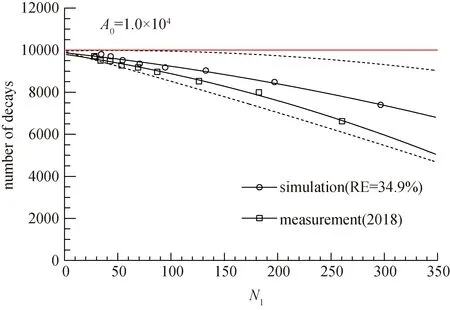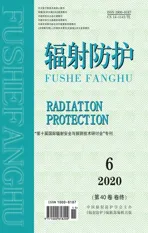Verification of modified sum-peak method in Monte Carlo simulation of full energy peak and sum-peak efficiencies of a HPGe detector
2021-01-28TsukasaAsoYoshimuneOgataHidesukeItadzu
Tsukasa Aso,Yoshimune Ogata,Hidesuke Itadzu
(1.Electronics and Computer Engineering,National Institute of Technology,Toyama College,1-2 Ebie Neriya,Imizu 9330293,Japan;2.Radioisotope Research Center Medical Division,Nagoya University,65 Tsurumai-cho,Showa-ku,Nagoya 4668550,Japan;3.SEIKO EG&G Co.Ltd;1-9 Nakase,Mihama-ku,Chiba 2618507,Japan)
Abstract:The modified sum-peak method estimates radioactivity by using only the peak and the sum-peak count rates.To verify the modified sum-peak method,the dependence of the full energy peak efficiency on the source-to-detector distance in a high-purity germanium detector system was studied using a Geant4 Monte Carlo simulation.The effect of the dead-layer in the germanium crystal was estimated by reference to experiments on 241Am and the relative efficiency of the detector.The peak efficiency dependence on the source-to-detector distance was compared between the simulation and measurements.The modified sum-peak method is discussed with respect to these peak efficiencies.
Key words:Geant4 Monte Carlo simulation;sum-peak method;peak efficiency;HPGe;60Co
A reliable and practical method for estimating radioactivity is becoming increasingly important in environmental monitoring.High-purity germanium (HPGe) detectors are widely used to analyze energy spectra for discriminating radionuclides and determining the radioactivity of environmental samples.Typically,a relative measurement is used to determine the radioactivity of a sample,which references the full energy peak efficiency (FEPE) of standard sources to compensate detection efficiency of the measurement system.However,such standard sources are not always available,since they need to be similar to the sample in both dimensions and type of material.
Absolute measurements,in contrast,directly determine the radioactivity from the measured count rates.The sum-peak method is an absolute measurement technique that can be used for radionuclides emitting more than one photon per decay[1].However,the conventional sum-peak method is difficult to apply to a sample containing multiple radionuclides,because it requires the total count rate of each radionuclide as well as the full energy peak and the sum-peak count rates.The modified sum-peak method[2]is based on the conventional sum-peak method,but uses only the peak count rates and the sum-peak count rate.Therefore,it can be applied to samples containing multiple radionuclides.
Although the modified sum-peak method does not require the FEPE to estimate the radioactivity,it should be verified with the peak efficiencies.Several studies have been reported on optimizing simulations of FEPEs in terms of the gamma ray energy dependence in HPGe detectors.However,the dependence of the FEPE and the sum-peak efficiency (SPE) on the source-to-detector (S-D) distance is crucial in the modified sum-peak method.These peak efficiencies are sensitive to the geometric configuration of the detector system,the dead-layer thickness in the Ge crystal and the angular correlation of the two gamma rays.
We previously reported on the verification of a Geant4 based Monte Carlo simulation for an n-type HPGe detector system (GMX-25190,ORTEC)[3].In this paper,the FEPE and SPE of60Co in the simulation are compared to measurements of a p-type HPGe detector system (GEM-35190,ORTEC),which is known to form a thicker dead-layer in the Ge crystal than n-type HPGe detector systems.The results are evaluated in terms of relative efficiency (RE),FEPE and SPE with the dead-layer thickness estimated from comparisons of the simulation with241Am and60Co experiments.
1 Materials and Methods
1.1 Modified sum-peak method
The modified sum-peak method[2]is based on the conventional sum-peak method.It removes a term related to the total count rate from the fundamental formula for the conventional sum-peak method.The fundamental formula for the modified method is:
(1)

1.2 HPGe detector system simulation
We used a Geant4 based HPGe detector system simulation.The Geant4 simulation toolkit[4]provides the comprehensive physics processes needed to calculate the energy spectrum by simulating particle transport from the nuclear decay to detection.The version of Geant4 used in this study was 10.04,patch-01.
The simulation modeled an ORTEC HPGe p-type coaxial photon detector.The basic parameters were taken from the manufacturer’s datasheet for GEM-35190.A schematic view of the HPGe detector endcap is shown in Figure 1.The Ge crystal is equipped with a crystal holder and installed inside the cylindrical detector endcap.The detection window consists of aluminized Mylar,a vacuum and magnesium layers,and it is covered by a copper layer of the endcap.All the materials are taken from the NIST material database in Geant4.
The dimensions and positions of the Ge crystal inside the endcap were checked using an X-ray imaging system,SIMENS Ysio Max.The Ge crystal size is consistent with the value in the datasheet.Although the datasheet gave a thickness of the vacuum layer in the detection window of 3 mm,it was estimated to be 4.37 mm from the image.We used the estimated thickness of the vacuum layer in the simulation geometry.
The Ge crystal possibly has a dead-layer at the crystal surface,in which electrical signals induced by photons are not detectable.To account for the dead-layer in the simulation,a scoring volume was defined for the Ge crystal,which represents the effective volume of the detector.The energy spectrum was calculated for the energy deposited in the effective volume.
The physics list in Geant4 defines the physics processes to be applied to particles.Our physics list takes into account all particles and interactions including the radioactive decay of isotopes and the electromagnetic physics for photons,electrons and positrons.The electromagnetic interactions of photons with materials are simulated with the G4EmStandardPhysics option3,which takes into account photoelectric effect,Compton scattering,and gamma conversions.
Radionuclide of241Am was disintegrated using G4RadioactiveDecayPhysics.An in-house primary generator was used for60Co in which the two gamma rays are generated with directions determined by the angular correlation functionw(θ)[3].The effect of the angular correlation is critical in the modified sum-peak method,because it varies with the S-D distance.We have verified that the primary generator reproduces a valid effective angular correlation with the S-D distance described in[5].
A point source was placed at a certain distance from the surface of the detector endcap along the detector axis.The energy deposited in the effective volume of the Ge crystal was accumulated per decay.The detected energy was then calculated by emulating the detector response according to the energy dependent energy resolution of the detector.Finally,the gamma-ray spectrum was collected as a series of detected energies for each decay.
The counts in the peak distribution were calculated by fitting the energy spectrum around the peak area with a sum of exponential and Gaussian functions in the CERN ROOT analysis tool[6].The FEPE and SPE were then calculated for these peak counts divided by the number of decays in the simulation.

Fig.1 Schematic view of the HPGe detector endcap.(units:mm)
1.3 Experiments
The measurements were conducted with the HPGe detector GEM-35190 in 2018.Our detector was purchased in 1991 and has been maintained with a high voltage adjustment and kept warm some of the time.During its twenty-seven years of operation,degradation of RE has been observed as shown in Tab.1,which is presumably due to aging of the Ge crystal.
The60Co source was prepared as a point-like source from standard solutions calibrated by the Japan Radioisotope Association (JRIA).A concentration of the standard solution was drop-deposited and dried on thin polytetrafluoroethylene (PTFE) sheets of 50 μm thickness,and then sealed by sandwiching with plastic sheets of 0.1-mm thickness.The diameter and thickness of the source spot were about 3 mm and under 0.05 mm,respectively.The activity in the experiment was 8.030 ±0.042 kBq.Details of the source preparation are described in [2].The241Am source is commercially available plastic-sealed standard source.The activity in the experiment was 380±30 kBq.All measurements were performed to accumulate more than 10,000 counts in the peak area,and therefore,the statistical uncertainty associated with the counts is less than 1%.

Tab.1 Relative efficiency (RE)
2 Results
2.1 Estimation of dead-layer thickness with 241Am experiment
The thickness of the dead-layer at the surface of the Ge crystal was estimated by comparing the simulated and measured FEPEs for 59.5 keV gamma rays from241Am.The experiment was conducted in 2018 by placing an241Am point source at a distance of 250 mm from the surface of the detector endcap along the detector axis.In this condition,the gamma rays are assumed to form a uniform irradiation field perpendicular to the crystal surface,and the behavior of the FEPE becomes stable independent of minor shifts of the S-D distance.The experimental result for the 59.5 keV FEPE was (0.165 ±0.013)%.The simulation was performed in the same configuration as the experiment and was repeated for various thickness of the dead-layer at the top surface of the Ge crystal.The 59.5 keV FEPE dependence on the thickness of the dead-layer in the simulation was compared along with the measured result.The optimal thickness of the dead-layer was estimated to be 1.11±0.10 mm.
2.2 Estimation of effective volume with relative efficiency measurements
The RE is defined as the ratio of the 1.33-MeV peak count rate for60Co in the HPGe detector to that in a NaI(Tl) detector,where the NaI(Tl) crystal is 3 inches in diameter and 3 inches in length and the point source is 25 cm upstream from the surface of the detector along the detector axis.The efficiency of a NaI(Tl) scintillation detector is commonly known to be 1.20×10-3.
Adopting a 1.11 mm thickness dead-layer in the simulation for both the top and side surfaces of the Ge crystal,the RE was calculated to be 39.5%.Although the thickness of the dead-layer was determined from the result of the experiment in 2018,the simulation result for the RE is consistent with the measured RE of 40.1% in 1991.It is considered that the dead-layer at the surface had only a minor extension since it has been supplied.Nevertheless,a non-negligible degradation of the RE has been observed after 2017.Therefore,we assumed that the degradation of the RE was caused by the formation of an additional dead-layer at the bottom of the Ge crystal.
To estimate the thickness of the additional dead-layer,the simulation was repeated by varying the thickness of a bottom dead-layer in the Ge crystal.The dependence of the RE on the thickness of the bottom dead-layer was compared to the measured RE.The estimated thickness of the bottom dead-layer in the 2018 experimental condition was estimated to be 12.75±0.32 mm.
2.3 Dependence of peak efficiency on endcap-to-source distance
The simulation was configured to represent the60Co measurement conducted on 2018.The simulation adopted dead-layer thicknesses at the top,side and bottom surface layers of 1.11 mm,1.11 mm and 12.75 mm,respectively,for which the RE is consistent with the measurements.


The errors are two standard deviations of statistical uncertainty.Fig.2 Comparison of the dependence of the efficiency on E-S distance
2.4 Radioactivity calculation in the modified sum-peak method


The solid lines are fitting results.The area between two dashed lines represents the systematic error of to the simulation result. dependence on N1 for the simulation and measurements
3 Discussions



(2)


Tab.2 Comparison of normalized peak efficiencies and for various E-S distances
4 Conclusions
The modified sum-peak method was verified in terms of the peak efficiencies in a p-type HPGe detector system by using a Geant4 based Monte Carlo simulation.By taking into account the dead-layers,the measured peak efficiencies were reproduced for E-S distances larger than 4 cm.The activity of60Co calculated in the simulation using the modified sum-peak method was in good agreement with the measurement.
Acknowledgements:The authors wish to thank Mr.Ryuta Makino for his contribution in the analysis of this study.
